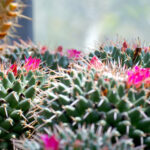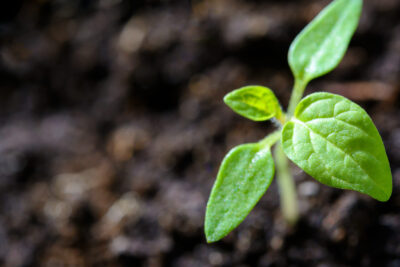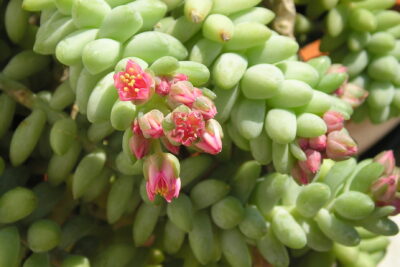
Black Beauty: A Guide to Succulents with Stunning Black Leaves

Succulents have become increasingly popular in recent years, with their unique and diverse range of shapes, colors, and textures. Among the many captivating varieties, one that stands out is the black beauty succulent. With its striking dark foliage, this plant adds a touch of elegance and drama to any garden or indoor space. We will explore the black beauty succulent and delve into its characteristics and care requirements.
In this comprehensive guide, we will discuss:
- The origins and types of black beauty succulents
- The distinctive features of black beauty succulents
- How to care for black beauty succulents, including watering, lighting, and temperature requirements
- Propagation techniques for growing more black beauty succulents
- Common pests and diseases that may affect black beauty succulents and how to prevent or treat them
- Design ideas and tips for incorporating black beauty succulents into your garden or indoor space
Whether you are a seasoned succulent enthusiast or just starting your succulent collection, this guide will provide you with all the information you need to successfully grow and enjoy the beauty of black beauty succulents.
- Choose succulents with naturally black leaves, such as Aeonium 'Zwartkop' or Echeveria 'Black Prince'
- Provide ample sunlight for your black-leaved succulents to enhance their dark color
- Water your succulents sparingly and allow the soil to dry out between waterings
- Use well-draining soil to prevent root rot and promote healthy growth
- Avoid over-fertilizing your black-leaved succulents, as it can lead to leggy growth
- Protect your succulents from frost or extreme temperatures
- Regularly remove dead or diseased leaves to maintain the plant's overall health
- Consider using black pebbles or rocks as a decorative mulch to enhance the visual impact of your black-leaved succulents
- Frequently Asked Questions
Choose succulents with naturally black leaves, such as Aeonium 'Zwartkop' or Echeveria 'Black Prince'
Black Beauty: A Guide to Succulents with Stunning Black Leaves
When it comes to succulents, there is a wide variety of shapes, colors, and sizes to choose from. One particular type that has gained popularity in recent years is succulents with stunning black leaves. These unique plants add a touch of elegance and drama to any garden or indoor space.
If you're looking to incorporate some black beauty into your succulent collection, here are a few varieties to consider:
- Aeonium 'Zwartkop': Also known as the Black Rose, this succulent features rosettes of dark, almost black, foliage. The leaves have a velvety texture, adding to its allure. Aeonium 'Zwartkop' is a great choice for both indoor and outdoor settings.
- Echeveria 'Black Prince': This striking succulent showcases deep purple, almost black, rosettes. The leaves have a glossy finish, which contrasts beautifully against the bright green center. Echeveria 'Black Prince' is a low-maintenance plant that thrives in both sun and partial shade.
These succulents with black leaves are not only visually stunning but also relatively easy to care for. Here are a few tips to keep them healthy:
 Best Trailing Succulents: Explore Our Top Picks for Cascading Beauty
Best Trailing Succulents: Explore Our Top Picks for Cascading Beauty- Light: Succulents with black leaves generally prefer bright, indirect light. Place them near a window where they can receive a few hours of sunlight each day.
- Watering: Like most succulents, these black beauties have low water needs. Allow the soil to dry out completely between waterings, and be cautious not to overwater, as this can lead to root rot.
- Soil: Use a well-draining soil mix specifically formulated for succulents. This will prevent water from sitting around the roots, which can cause them to rot.
- Temperature: Succulents with black leaves generally prefer moderate temperatures between 65-75°F (18-24°C). Avoid exposing them to extreme heat or cold.
With their striking black foliage, succulents like Aeonium 'Zwartkop' and Echeveria 'Black Prince' are sure to make a bold statement in your garden or home. Whether you are a seasoned succulent enthusiast or just starting your collection, these black beauties are worth adding to your plant family.
Provide ample sunlight for your black-leaved succulents to enhance their dark color
To maintain the stunning black color of your succulents' leaves, it is crucial to provide them with ample sunlight. Succulents with black leaves are unique and require more sunlight compared to their green-leaved counterparts. The intense sunlight not only enhances their dark color, but it also promotes their overall health and growth.
When placing your black-leaved succulents, ensure they receive at least 6-8 hours of direct sunlight per day. If you are keeping them indoors, place them near a south-facing window where they can soak up the maximum amount of sunlight. In areas with hot climates, it is advisable to provide some shade during the peak afternoon hours to prevent the leaves from scorching.
Remember, sunlight is the key to maintaining the striking black color of your succulents' leaves. Without adequate sunlight, their leaves may fade or turn green, losing the unique allure that makes them so captivating.
Water your succulents sparingly and allow the soil to dry out between waterings
When it comes to succulents with stunning black leaves, proper watering is key to ensure their health and longevity. Succulents are known for their ability to store water in their leaves and stems, making them more tolerant to drought conditions. Therefore, it is important to water them sparingly and allow the soil to dry out between waterings.
Overwatering succulents can lead to root rot, which can be fatal for these plants. To prevent this, make sure to use well-draining soil specifically designed for succulents. This type of soil allows excess water to flow out of the pot, preventing the roots from sitting in water and potentially rotting.
When watering your succulents, it is best to use the "soak and dry" method. This means thoroughly watering the soil until it is saturated and then allowing it to completely dry out before watering again. The frequency of watering will depend on various factors such as the climate, humidity, and the specific needs of the succulent species you have.
 Succulents: Annuals or Perennials in Their Natural Habitat?
Succulents: Annuals or Perennials in Their Natural Habitat?One way to determine if your succulent needs watering is by checking the moisture level of the soil. Insert your finger about an inch into the soil, and if it feels dry, it's time to water. However, if it still feels slightly moist, it's best to wait a little longer before watering.
Remember, succulents are adapted to survive in arid conditions, so they prefer to be underwatered rather than overwatered. It's always better to err on the side of caution and water less frequently than to risk overwatering and damaging your precious black beauties.
Use well-draining soil to prevent root rot and promote healthy growth
When it comes to succulents with stunning black leaves, one of the key factors in their successful growth is using well-draining soil. Succulents, including those with black leaves, are known for their ability to store water in their leaves, stems, or roots. However, they are also prone to root rot if their soil retains too much moisture.
By using well-draining soil, you create an environment where excess water can easily escape, preventing waterlogged roots. This promotes healthy growth and reduces the risk of root rot, which can be detrimental to the overall health of your black beauty succulents.
When selecting soil for your succulents, opt for a mix specifically formulated for succulent plants or cacti. These mixes usually consist of a combination of organic matter, such as peat moss or coconut coir, and inorganic matter like perlite or pumice. The organic matter helps retain some moisture, while the inorganic matter ensures excellent drainage.
When potting your succulents, make sure to choose a container with drainage holes at the bottom. This allows any excess water to escape freely, preventing it from pooling at the bottom and potentially causing root rot.
 Low-Maintenance Plants with Succulent-Like Care and Appearance
Low-Maintenance Plants with Succulent-Like Care and AppearanceTips for well-draining soil:
- Choose a succulent-specific soil mix
- Look for a balance of organic and inorganic matter
- Pot your succulents in containers with drainage holes
Remember, using well-draining soil is crucial for the success of your black beauty succulents. It not only prevents root rot but also mimics their natural habitat, where they typically grow in sandy or rocky soil with excellent drainage.
Avoid over-fertilizing your black-leaved succulents, as it can lead to leggy growth
Succulents with stunning black leaves, also known as black-leaved succulents, have gained immense popularity among plant enthusiasts. Their unique and striking appearance adds a touch of elegance to any indoor or outdoor space. However, these captivating plants require special care to ensure their health and beauty is maintained.
One crucial aspect to consider when caring for black-leaved succulents is fertilization. While fertilization is essential for the overall growth and health of plants, it is crucial to avoid overdoing it with black-leaved succulents. Over-fertilizing can result in leggy growth, which means the plant becomes elongated and weak, compromising its visual appeal.
Here are some essential tips to keep in mind when fertilizing your black-leaved succulents:
1. Choose a well-balanced fertilizer
When selecting a fertilizer for your black-leaved succulents, opt for a well-balanced formula specifically designed for succulents and cacti. A balanced fertilizer contains an equal ratio of nitrogen, phosphorus, and potassium, providing the necessary nutrients without causing excessive growth.
 Discover Fred Ives' Top Recommended Succulent Varieties for Your Home
Discover Fred Ives' Top Recommended Succulent Varieties for Your Home2. Dilute the fertilizer
It is crucial to dilute the fertilizer before applying it to your black-leaved succulents. Mixing the fertilizer with water according to the package instructions ensures that the plants receive a controlled amount of nutrients. Avoid using concentrated fertilizers, as they can be too harsh for these delicate plants.
3. Follow a regular fertilization schedule
Establish a regular fertilization schedule for your black-leaved succulents. During the growing season, which typically occurs in spring and summer, fertilize your plants once a month. However, reduce the frequency to every two to three months during the dormant period, which usually takes place in fall and winter.
4. Apply sparingly
When applying the fertilizer, remember that less is more. Apply a small amount of the diluted fertilizer to the soil around the base of the plant, avoiding direct contact with the leaves. Over-fertilizing can burn the roots and cause irreversible damage to your black-leaved succulents.
Remember: Black-leaved succulents have a natural beauty that does not require excessive fertilization. By following these tips and providing them with the right amount of nutrients, you can ensure their stunning black leaves remain healthy and vibrant for years to come.
Protect your succulents from frost or extreme temperatures
One of the most important aspects of caring for succulents with stunning black leaves is protecting them from frost or extreme temperatures. These plants are typically native to warm and arid climates, so they are not well-suited to cold or freezing conditions.
To ensure the health and longevity of your black-leaved succulents, it is crucial to take certain precautions during the winter months or in regions with harsh climates. Here are some tips to help you protect your succulents:
 Discover the Perfect Sedum Variety for a Vibrant Blue Succulent
Discover the Perfect Sedum Variety for a Vibrant Blue Succulent1. Provide adequate insulation
During winter or cold weather, you can insulate your succulents by covering them with a frost cloth or floating row cover. These protective fabrics help trap heat and create a microclimate around the plants, shielding them from freezing temperatures.
2. Move them indoors
If you live in an area with extremely cold winters, it may be best to bring your succulents indoors. Find a bright spot near a window where they can receive sufficient sunlight. Be mindful of the temperature indoors as well; avoid placing them near drafty windows or heating vents.
3. Avoid overwatering
During colder months, succulents enter a dormant phase and require less water. Overwatering can lead to root rot, which is especially harmful in cold conditions. It is recommended to reduce watering frequency and allow the soil to dry out between waterings.
4. Choose suitable containers
When selecting containers for your black-leaved succulents, opt for materials that provide insulation, such as ceramic or thick plastic. These materials can help regulate soil temperature and protect the roots from extreme cold or heat.
5. Monitor temperature fluctuations
Keep an eye on weather forecasts and be prepared to take action when temperatures drop. Consider using a thermometer to monitor the temperature around your succulents and take necessary steps to protect them if the mercury plummets.
By following these guidelines, you can safeguard your black-leaved succulents from the detrimental effects of frost or extreme temperatures. Remember, prevention is key when it comes to maintaining the beauty and health of these unique plants.
Regularly remove dead or diseased leaves to maintain the plant's overall health
 Discover the tallest succulent tree species for your garden
Discover the tallest succulent tree species for your gardenRegularly removing dead or diseased leaves is essential for maintaining the overall health of your succulents. Not only does it improve the appearance of the plant, but it also helps prevent the spread of diseases and pests.
When a succulent leaf starts to turn black, it is often a sign of decay or disease. It is crucial to identify and remove these leaves promptly to prevent further damage to the plant. Use a pair of clean, sharp scissors or pruning shears to carefully cut off the affected leaves at their base.
By regularly removing dead or diseased leaves, you are allowing the plant to allocate its energy towards healthy growth and development. This practice also promotes better air circulation around the plant, reducing the risk of fungal infections.
Additionally, removing black leaves helps maintain the aesthetic appeal of your succulents. Black leaves can be unsightly and may detract from the overall beauty of the plant. By keeping your succulents free from black leaves, you can showcase their stunning black foliage and enhance the visual impact of your collection.
Consider using black pebbles or rocks as a decorative mulch to enhance the visual impact of your black-leaved succulents
Black pebbles or rocks can be a fantastic addition to your succulent garden, especially if you're looking to enhance the visual impact of your black-leaved succulents. Using black pebbles or rocks as a decorative mulch not only adds a touch of elegance but also helps in retaining moisture and preventing weed growth around your plants.
When selecting black pebbles or rocks, opt for those with a smooth surface and uniform color to create a sleek and polished look. These contrasting elements will make your black-leaved succulents stand out even more.
 Discover the Top Orange Succulent Plants to Enhance Your Home
Discover the Top Orange Succulent Plants to Enhance Your HomeBefore applying the black pebbles or rocks, make sure to prepare the soil properly. Remove any weeds or debris and loosen the soil to promote better drainage. This step will ensure that your succulents receive the right amount of water without risking root rot.
Once the soil is prepared, spread a layer of black pebbles or rocks around your succulents. Aim for a thickness of about 1-2 inches to provide adequate coverage and insulation. This layer will help regulate soil temperature, protect the roots from extreme weather conditions, and reduce evaporation.
Additionally, the dark color of the black pebbles or rocks absorbs heat from the sun, creating a mini microclimate around your succulents. This can be beneficial, especially if you live in a region with cooler temperatures or if you want to extend the growing season for your black-leaved succulents.
Another advantage of using black pebbles or rocks is that they can act as a natural weed deterrent. By forming a barrier between the soil and the surrounding environment, they prevent weed seeds from germinating and competing for nutrients with your precious succulents.
Keep in mind that while black pebbles or rocks can enhance the beauty of your succulent garden, they should not be used as the sole medium for planting. Succulents require a well-draining soil mix to thrive, so be sure to blend in appropriate potting soil or sand with the existing soil before planting your black-leaved succulents.
Incorporating black pebbles or rocks as a decorative mulch in your succulent garden can elevate the overall aesthetics and provide numerous benefits. From enhancing the visual impact of your black-leaved succulents to promoting better drainage and preventing weeds, this simple addition can make a world of difference.
Frequently Asked Questions
1. What is Black Beauty?
Black Beauty is a type of succulent plant that is known for its stunning black leaves. It is a popular choice among plant enthusiasts for its unique color and texture.
 Can Succulents Display Both Red and Purple Colors Simultaneously?
Can Succulents Display Both Red and Purple Colors Simultaneously?2. How do I care for Black Beauty succulents?
Black Beauty succulents require bright but indirect light and well-draining soil. They should be watered sparingly, allowing the soil to dry out between waterings. It is also important to protect them from frost and extreme temperatures.
3. Can I grow Black Beauty indoors?
Yes, Black Beauty succulents can be grown indoors. They thrive in bright, indirect light near a window. Make sure to rotate the plant occasionally to ensure even growth.
4. How often should I fertilize my Black Beauty succulents?
Black Beauty succulents only require fertilization during their active growing season, which is typically in spring and summer. Use a balanced, water-soluble fertilizer diluted to half strength and apply it every 2-4 weeks.
If you want to read more articles similar to Black Beauty: A Guide to Succulents with Stunning Black Leaves, you can visit the Varieties and Colors category.






You Must Read